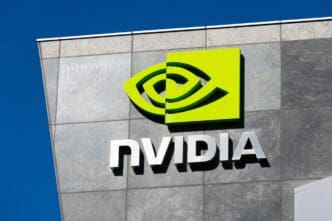Executive Summary
The Story So Far
Why This Matters
Who Thinks What?
Nvidia, the leading artificial intelligence (AI) chipmaker, has achieved a market capitalization of $4.9 trillion as of October 29, 2025, making it the highest-valued stock globally and the first company to surpass a $4 trillion valuation. This milestone underscores the company’s central role in building the infrastructure for the future of AI, even as questions arise regarding its continued growth trajectory and potential to reach a $10 trillion valuation by 2030.
Nvidia’s Dominance in AI Infrastructure
Nvidia has become synonymous with artificial intelligence, with its graphics processing units (GPUs) powering the most advanced generative AI applications. Analysts estimate the company controls between 70% and 95% of the AI chip market, solidifying its position despite increasing competition.
The company is further sharpening its market edge by rolling out vertically integrated hardware and software solutions. These offerings, such as Nvidia’s CUDA software designed for seamless developer interaction with its GPUs and data centers, aim to simplify and accelerate client operations. Notably, Nvidia recently shipped the DGX Spark, described as the world’s smallest supercomputer, to Tesla.
Strong Financial Performance and Growth
Nvidia’s stock has delivered significant returns for investors, increasing nearly 1,500% over the past five years, equating to an approximate 74% annual growth rate. This performance reflects the market’s recognition of the immense opportunities within the AI sector.
In its fiscal third quarter of 2025, which concluded on July 27, Nvidia reported a 56% year-over-year increase in sales. This growth was largely propelled by a 73% surge in data center sales. The company anticipates potentially even stronger fourth-quarter results, as sales in China, which were previously on hold due to government regulations, are expected to resume.
Future Architecture and Valuation Outlook
While Nvidia is still in the process of rolling out its latest Blackwell architecture, which has already contributed to a 17% quarter-over-quarter sales increase in Q3, it is also preparing for the next generation. The company plans to launch its Vera Rubin line of AI architecture in 2026, designed to handle even greater data loads.
Looking ahead, the prospect of Nvidia reaching a $10 trillion market capitalization by 2030 is a subject of investor discussion. Achieving this would require the stock to increase by 104% from its current valuation. Based on its current price-to-sales (P/S) ratio of 30, this would necessitate an increase in total trailing 12-month sales to $333 billion from the current $165.2 billion, implying a compound annual growth rate (CAGR) of at least 15% over the next five years. However, a potential decline in the P/S ratio as growth moderates could mean that sales would need to reach $538 billion, requiring a CAGR of 27% based on its 10-year average P/S ratio of 18.6.
Conclusion
Nvidia’s journey to becoming the world’s most valuable company highlights its pivotal role in the AI revolution. While the company continues to innovate with new architectures and integrated solutions, its path to a $10 trillion valuation by 2030 hinges on sustained high growth rates and market dynamics. The author of the article believes this target is achievable, though acknowledging the inherent uncertainties of the stock market.







